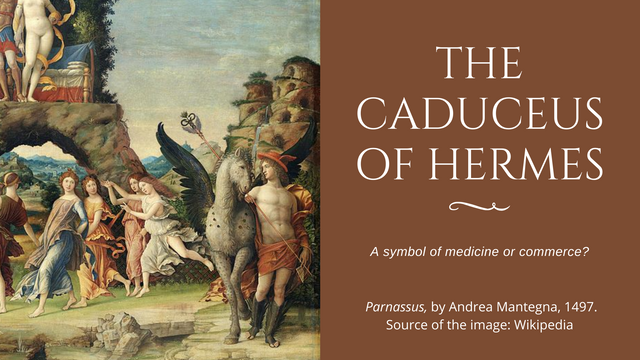Special Mythological Note: The Caduceus of Hermes, a symbol of Medicine or Commerce?
Author's note: The following article was originally published in Spanish language in my Blurt blog, on October 4th, 2021.
In the last post, we exposed the multifaceted Hermes, the messenger of the gods and a divinity revered by merchants, athletes, and thieves alike for his many attributes. We have addressed the various myths that gave rise to the attributes of Psychopompos (Guide of souls) and Logios (God of eloquence) and how in Rome he has come to be compared to the German Wotan.
The different elements with which it can easily be identified have been vaguely mentioned, but there's one in particular that deserves a special mythological note, because its symbolism easily lends itself to confusion within the health professionals guild: The kerykéion, or caudceus.

Source of the image: Wikipedia
Hermann Steuding (1961) mentions that the caduceus was the staff with which a herald or messenger of a ruler was identified. In his function as the herald of the divinities, Hermes carried a caduceus made up of two serpents coiled around the staff; at the tip of it there were spread wings. The object itself gave him the power to guide souls to the Underworld, to transmit the designs of the gods, and to preside over commercial and political agreements.
For Francisco Diez de Velasco (1988), the kerykéion grants Hermes an unique status within the organization of the Greco-Latin cosmogonic space, as it symbolizes power over ambiguous worlds, understanding them as the limits between life and death, and transforming him into one of the two divinities that can enter and leave the Underworld with no harm.
Symbol of Medicine or Commerce?
From the Renaissance to the present day the confusion between the Caduceus of Hermes and the Rod of Asclepius has been remarkable; the first milestone of this confusion can be found in the books printed by Johannes Froben in the Renaissance period, who erroneously used the Caduceus as a seal to distinguish medical books (Pino Andrade, 2014: 80). Another case of confusion was generated more or less in that same historical period when William Butts, King Henry the VIII of England's head physician, added it to his coat of arms (Murillo Godínez, 2010: 612).
Why is this confusion, being both symbols very different in appearance? It is possible that the answer could lie in one of the atributes of Hermes: the Psychopompos. The guide of souls, being in the middle of the limits between life and death. After all, Hermes is a multifaceted and liminal deity; he is able to preside over political and commercial treaties thanks to his eloquence, and he's the most competent to collect souls to the Underworld or guide those whose time has not yet come.
Consulted sources (Spanish)
- Diez de Velasco, Francisco. 1988. "Un aspecto del simbolismo del Kerykeion de Hermes", en: Gerión, núm. 6. Editorial de la Universidad Complutense de Madrid. Pp. 39 - 45. Obtained from: https://revistas.ucm.es/index.php/GERI/issue/view/GERI888812
- Murillo Godínez, Guillermo. 2010. "El símbolo de la medicina: la Vara de Esculapio o el Caduceo de Hermes", en: Medicina Interna de México. Vol. 26, núm. 6. Noviembre - diciembre. Pp. 608 - 615. Obtained from: https://www.medigraphic.com/cgi-bin/new/resumen.cgi?IDARTICULO=28441#:~:text=La%20Vara%20de%20Esculapio%20
- Pino Andrade, Raúl. 2014. "Mitología griega y medicina: Asclepio, su bastón y una confusión de larga data", en: Revista de la Facultad de Ciencias Médicas. Vol. 32, núm. 2. Septiembre. Universidad de Cuenca. Pp. 77 - 81. Obtained from: https://publicaciones.ucuenca.edu.ec/ojs/index.php/medicina/article/view/890
- Steuding, Herman. 1961. Mitología griega y romana. España. Editorial Labor. English version of the book: Greek and Roman Mythology.
Another Mythological Notes
- Greco-roman mythology: A brief introduction.
- Greek and Roman Mythology: Their differences.
- Creation, according to greco-roman mythology.
- Gaia and Uranus, the primordial divinities.
- The Titans, the predecessors of the gods.
- Titanomachy: Titans vs. Olympians.
- Prometheus, the titan who defied Zeus.
- Pandora, the lady of the amphora.
- The Twelve Olympians: From Greece to Rome.
- Zeus, the king of the gods (and the womanizers).
- Hera, the goddess of marriage and birth.
- Hades, the god of the Underworld and Wealth.
- Persephone, goddess of Spring and queen of the Underworld
- Demeter, goddess of Agriculture, Harvesting and Fertility
- Hermes, a multifaceted divinity
 Image modified in
Image modified in